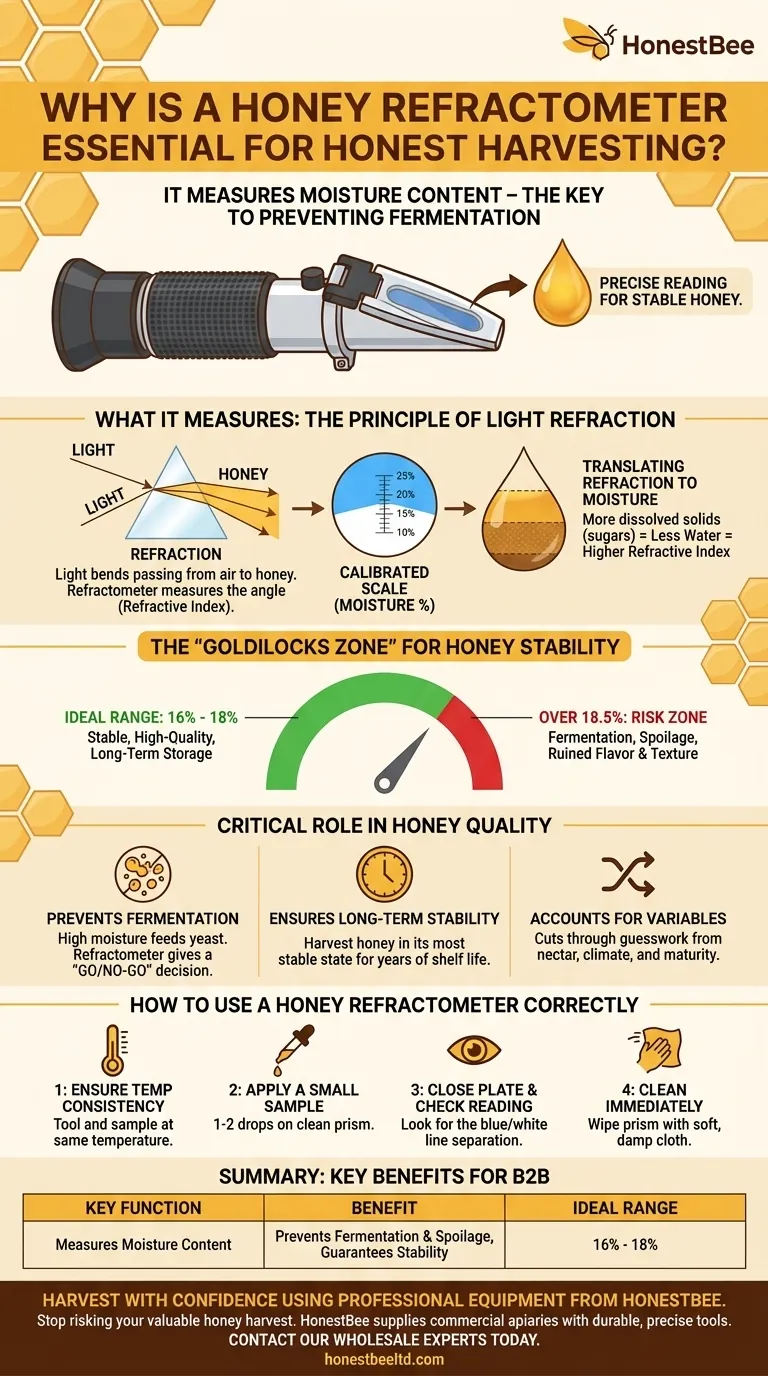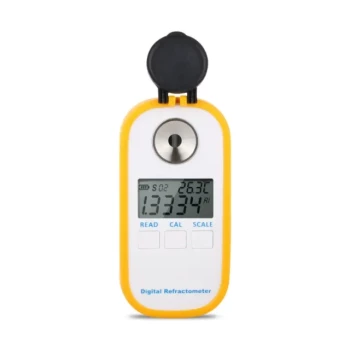In short, a honey refractometer is essential because it measures moisture content—the single most critical factor in preventing your honey from fermenting and spoiling. By providing a precise moisture reading, it tells you the exact moment your honey is stable and ready for harvest, protecting your investment of time and effort. Without it, you are essentially guessing, risking the loss of your entire harvest.
A honey refractometer removes the guesswork from harvesting. It provides the objective data needed to ensure your honey's moisture level is low enough (ideally 16-18%) to prevent fermentation, guaranteeing a high-quality, shelf-stable product.

What a Refractometer Actually Measures
A refractometer is a surprisingly simple optical tool that gives you a powerful piece of information. Its function is based on a fundamental principle of physics.
The Principle of Light Refraction
When light passes from the air into a liquid like honey, it bends. This bending is called refraction.
A refractometer measures the precise angle of this bend, known as the refractive index.
Translating Refraction to Moisture
The key insight is that the amount of dissolved solids in the honey—primarily sugars but also pollen and minerals—determines how much the light will bend.
More solids mean less water. Less water means a higher refractive index (more bending). The scale inside the refractometer is calibrated to translate this refractive index directly into a simple moisture percentage.
The "Goldilocks Zone" for Honey
For honey to be stable, its moisture content must be just right. The ideal range is typically between 16% and 18%.
If moisture is above 18.5%, naturally occurring yeast spores present in the honey can activate and begin the process of fermentation. This will ruin the flavor, aroma, and texture of the honey.
The Critical Role of Moisture in Honey Quality
Understanding and controlling moisture is not just a technical detail; it is the foundation of producing good honey. A refractometer is your primary tool for this control.
Preventing Fermentation
Fermentation is the number one enemy of harvested honey. High moisture creates the perfect environment for yeast to thrive, turning your valuable honey into a sour, bubbly, and unusable mess.
A refractometer gives you a clear "go" or "no-go" decision, preventing you from ever extracting honey that is destined to spoil.
Ensuring Long-Term Stability
Properly cured honey with low moisture content is one of nature's most stable foods, capable of lasting for years or even decades.
Using a refractometer ensures you are harvesting honey in its most stable possible state, perfect for long-term storage, gifting, or selling.
Accounting for Environmental Variables
You cannot determine moisture content by sight alone. Numerous factors influence it, including:
- Nectar source: Different flowers produce nectars with varying water content.
- Climate and weather: High humidity can significantly slow the bees' dehydration process.
- Honey maturity: Honey in uncapped cells is almost always too wet.
A refractometer cuts through all these variables to give you one simple, actionable number.
How to Use a Honey Refractometer Correctly
Getting an accurate reading is simple, but requires following a few key steps.
Step 1: Ensure Temperature Consistency
For the most accurate result, the refractometer and the honey sample should be at the same ambient temperature. Significant temperature differences can slightly skew the reading.
Step 2: Apply a Small Sample
Place one or two drops of honey onto the clean glass prism of the refractometer. A toothpick or the end of a hive tool works well for gathering a sample directly from the comb.
Step 3: Close the Plate and Check the Reading
Gently close the daylight plate over the honey sample. This will spread the honey into a thin, even layer. If you see air bubbles, gently wiggle the plate to remove them.
Hold the refractometer up to a natural light source and look into the eyepiece. You will see a scale with a distinct line separating a blue and white area. This line indicates the moisture percentage. If the scale is blurry, twist the eyepiece to focus it.
Step 4: Clean the Prism Immediately
After taking your reading, wipe the prism and daylight plate clean with a soft, damp cloth and dry it completely. Dried honey residue will ruin your next reading.
Making the Right Decision at Harvest Time
A refractometer transforms harvesting from a subjective guess into a precise, data-driven science. Use it to inform your final decision.
- If your primary focus is producing high-quality, stable honey for sale: Use a refractometer to ensure moisture is consistently below 18% across all supers before you begin extraction.
- If you are a hobbyist beekeeper concerned with preventing spoilage: A refractometer is your best insurance policy against losing a hard-earned harvest to fermentation.
- If you want to optimize your harvesting workflow: Test samples from different frames to make informed decisions about which are ready to pull and which need more time in the hive.
Ultimately, this simple tool empowers you to harvest with confidence, knowing your honey is at its absolute best.
Summary Table:
| Key Function | Benefit | Ideal Range |
|---|---|---|
| Measures Moisture Content | Prevents Fermentation & Spoilage | 16% - 18% |
| Provides Objective Data | Removes Harvest Guesswork | Below 18.5% |
| Ensures Honey Stability | Guarantees Long-Term Quality & Shelf Life | - |
Harvest with Confidence Using Professional Equipment from HONESTBEE
Stop risking your valuable honey harvest to guesswork. Ensure every batch is perfectly cured, stable, and ready for market. HONESTBEE supplies commercial apiaries and beekeeping equipment distributors with the durable, precise tools needed for success, including high-quality honey refractometers.
Contact our wholesale experts today to discuss your equipment needs and protect your investment.
Visual Guide

Related Products
- Precision Honey Refractometer Instrument for Quality Assessment
- Digital Honey Refractometer for Precision Measurement of Optimal Honey Quality
- HONESTBEE 72 Frame Industrial Electric Honey Extractor for Beekeeping
- Plastic Hand Crank 2 Frame Honey Extractor Low Price
- 6 Frame Manual Stainless Steel Honey Extractor Beekeeping Equipment
People Also Ask
- What are the key points for proper usage of a honey refractometer? Ensure Accurate Moisture Readings Every Time
- What are the key steps to using a honey refractometer? Ensure Honey Quality & Prevent Fermentation
- Why is a honey refractometer considered essential for commercial beekeepers? Ensure Honey Quality and Profitability
- Why is a honey refractometer important for beekeepers? Ensure Quality and Prevent Fermentation
- What is a honey refractometer? The Essential Tool for Perfect Honey Quality



















